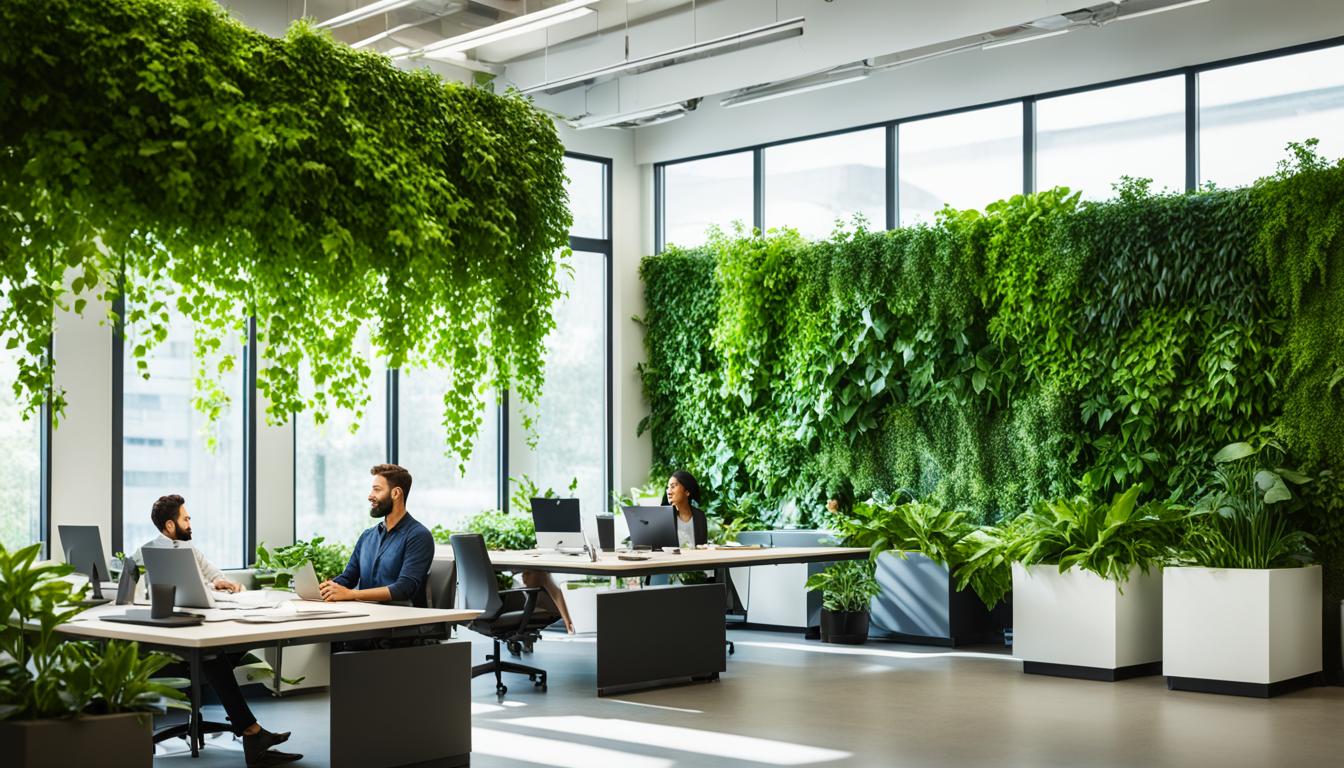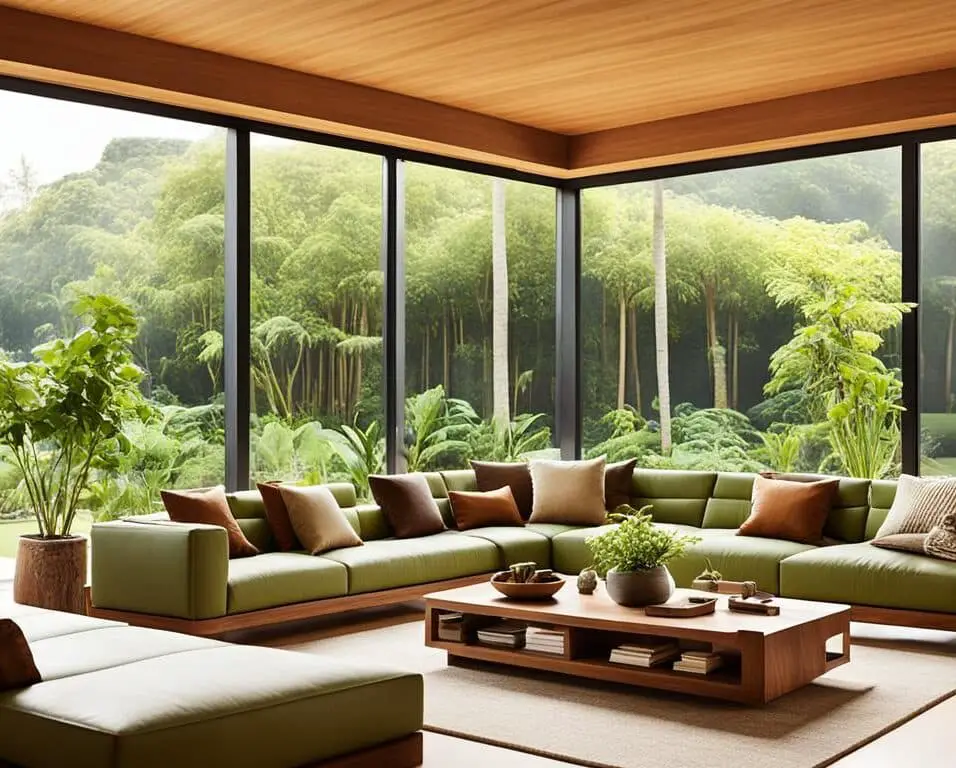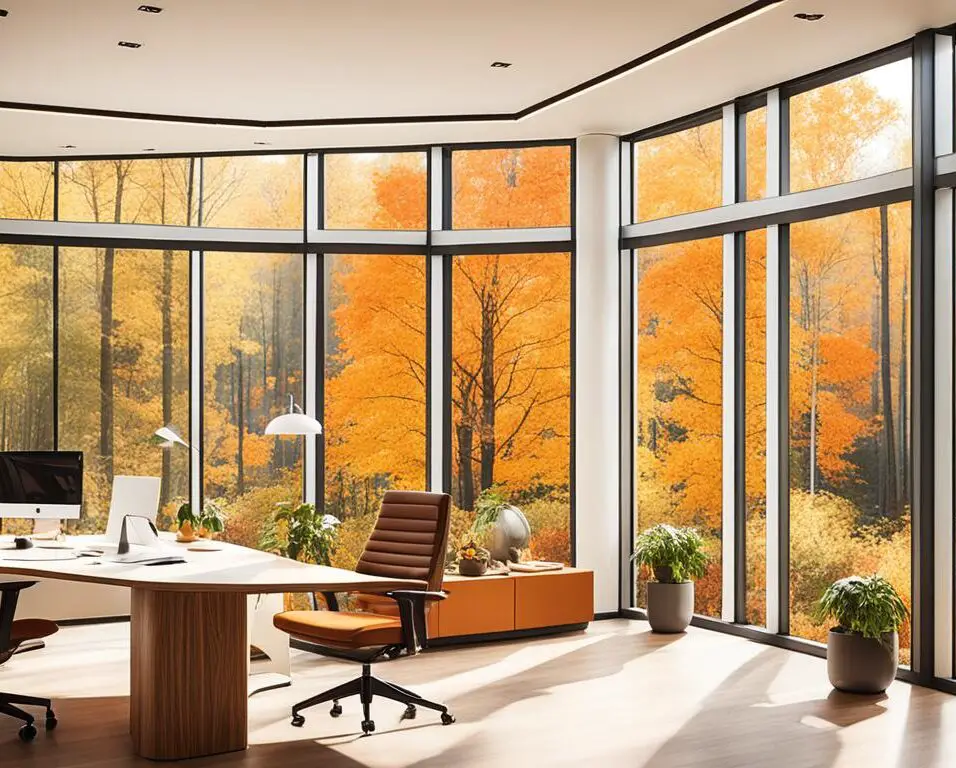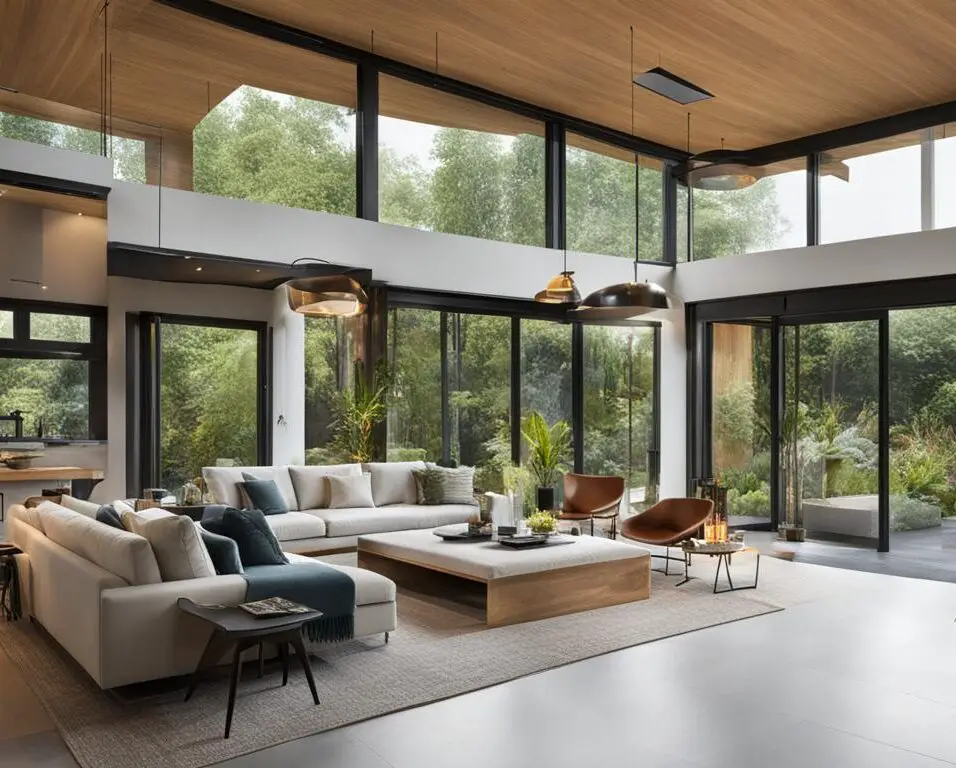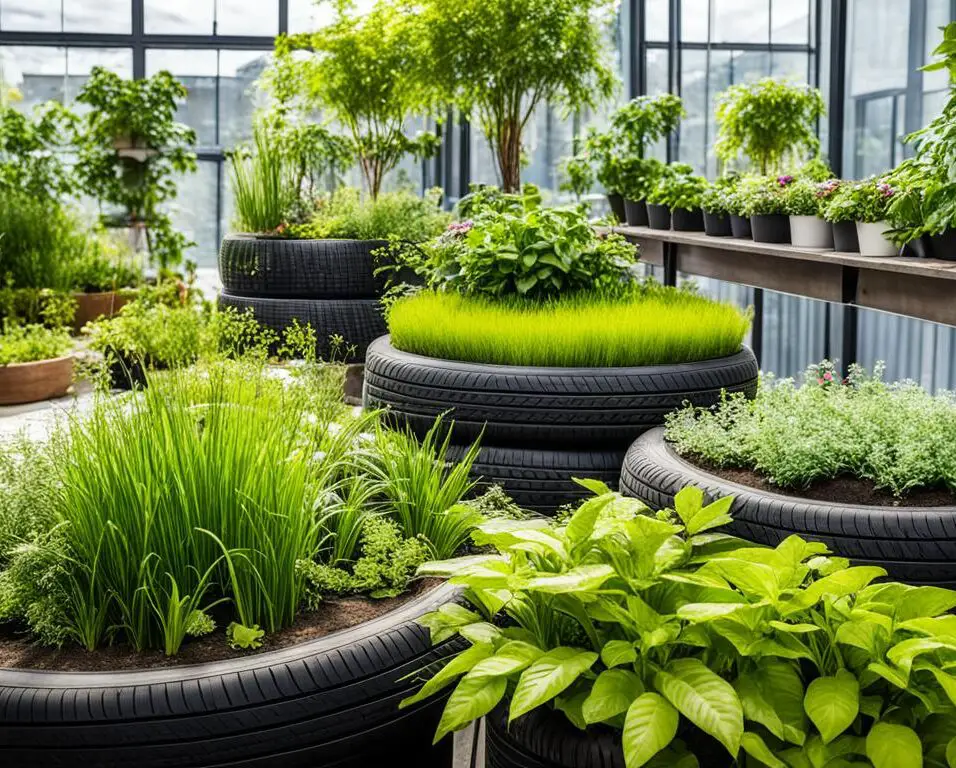Green Workspaces: Biophilic Design Strategies for Office Spaces
Hello, I’m excited to dive into the world of biophilic design and explore how it can transform office spaces into vibrant and inspiring green workspaces. Biophilic design is a unique approach that integrates elements of nature into the built environment, creating a harmonious balance between the natural world and our work settings.
The growing interest in biophilic design is driven by its proven benefits, including increased productivity, well-being, and overall happiness among employees. By incorporating natural elements into office spaces, we can create a more conducive environment that nurtures creativity, reduces stress, and enhances the overall quality of work life.
In this article, we will delve into various biophilic design strategies that can be implemented in office spaces to transform them into green workspaces. From the use of natural materials to the integration of plants and greenery, we will explore how these strategies can enhance the aesthetics, functionality, and overall experience of office environments.
So, let’s embark on this journey of discovering how biophilic design can revolutionize office spaces, improve employee well-being, and create inspiring work settings that truly connect us with nature.
- Biophilic design integrates elements of nature into the built environment.
- It has numerous benefits for office spaces, including increased productivity and well-being.
- This article explores biophilic design strategies for creating green workspaces.
- The strategies include the use of natural materials, plants, and maximizing natural light.
- Several successful case studies showcase the implementation of biophilic design in office spaces.
The Benefits of Biophilic Design in Office Spaces
Biophilic design offers numerous benefits for office spaces, positively impacting employees’ health, happiness, and productivity. By incorporating natural elements into the office environment, such as plants, natural light, and organic materials, the aesthetic appeal and overall atmosphere of the workspace are greatly enhanced.
Reduced Stress and Improved Well-being
One of the significant benefits of biophilic design in office spaces is the reduction of stress levels among employees. Research has shown that exposure to nature and natural elements can lower stress hormones and promote relaxation, leading to improved mental well-being. The presence of greenery, like indoor plants or living walls, creates a calming effect and improves air quality, contributing to a healthier and more conducive work environment.
“Bringing elements of nature into office spaces creates a sense of calm and tranquility, creating a more positive and vibrant work environment.”
Enhanced Focus and Creativity
Biophilic design has also been found to enhance focus and boost creativity among employees. Natural elements, such as daylight and views of nature, promote better cognitive function and problem-solving abilities. Additionally, the use of organic materials, such as wood, can help create a warmer and more soothing atmosphere, stimulating creativity and innovation.
“Studies have shown that employees working in biophilic offices demonstrate increased cognitive function and higher levels of creativity.”
Increased Productivity and Satisfaction
Implementing biophilic design strategies in office spaces can lead to increased productivity and job satisfaction. The inclusion of natural elements creates a sense of connection to the environment, which has been shown to enhance overall job satisfaction and employee engagement. The presence of nature-inspired design elements, such as patterns and textures, fosters a more visually stimulating environment, making workspaces more appealing and enjoyable.
“Creating a biophilic office space can significantly improve employees’ productivity and job satisfaction, contributing to a positive and thriving work culture.”
In summary, biophilic design in office spaces offers a wide range of benefits that positively impact employees’ health, happiness, and productivity. By incorporating natural elements and creating a visually appealing and inviting environment, companies can create green workspaces that promote well-being, focus, and creativity. The implementation of biophilic design strategies can result in a more productive, satisfying, and harmonious work environment.
Biophilic Design Strategies for Office Spaces
When it comes to incorporating biophilic design in office spaces, there are several effective strategies that can be implemented. These strategies revolve around creating a harmonious blend between nature and the built environment, with the aim of enhancing productivity, well-being, and overall employee satisfaction in the workplace.
1. Use of Natural Materials
One key strategy is the utilization of natural materials such as wood and stone. These materials not only add warmth and aesthetic appeal to the office space but also connect employees with nature. Incorporating natural materials in furniture, flooring, and decorative elements can create a sense of authenticity and tranquility.
2. Integration of Plants and Greenery
Plants and greenery play a crucial role in biophilic design. They not only improve air quality but also introduce a calming and refreshing element into the office space. Consider incorporating plants in various areas, such as desktop plants, hanging or potted plants, and living walls. This will not only enhance the visual appeal but also bring the benefits of biophilic design to employees.
3. Maximization of Natural Light
Natural light is a vital element in biophilic design. It not only reduces reliance on artificial lighting but also provides a connection to the natural environment. Design office spaces with ample windows and skylights to maximize the flow of natural light. Utilize blinds and curtains to control glare while allowing daylight to permeate the workspace.
4. Incorporation of Natural Patterns and Textures
Incorporating natural patterns and textures in office spaces can create a calming and visually stimulating environment. Consider using wallpapers, fabrics, or carpets that replicate patterns found in nature, such as leaves or waves. Additionally, including natural textures, such as exposed brick walls or wooden accents, can add depth and interest to the workspace.
By integrating these biophilic design strategies, office spaces can transform into vibrant and rejuvenating environments that foster productivity, creativity, and employee well-being.
| Biophilic Design Strategies | Benefits |
|---|---|
| Use of Natural Materials | – Adds warmth and authenticity – Creates a calming atmosphere |
| Integration of Plants and Greenery | – Improves air quality – Enhances visual appeal – Promotes well-being |
| Maximization of Natural Light | – Reduces reliance on artificial lighting – Connects with the natural environment |
| Incorporation of Natural Patterns and Textures | – Creates a visually stimulating environment – Adds depth and interest |
Case Studies: Successful Implementations of Biophilic Design in Office Spaces
Several companies have successfully embraced biophilic design in their office spaces, creating environments that foster well-being and productivity. One notable case study is the LinkedIn office expansion in Singapore, which sought to reflect the essence of contemporary Singapore through its design. The project incorporated outdoor materials, commissioned artwork highlighting local landmarks, and a diverse range of workspace types.
This innovative design received recognition for its ability to blend nature and modernity, creating a dynamic and engaging workplace. By integrating biophilic elements, such as plants and natural textures, LinkedIn Singapore transformed its office space into a representation of the vibrant city it operates in.
Other companies have also embraced biophilic design principles to create green workspaces. Incorporating living walls, which are vertical gardens filled with plants, has become a popular approach. These living walls not only enhance the visual appeal of the office but also improve air quality by filtering pollutants and providing natural ventilation.
Natural light is another crucial component of biophilic design. Companies have prioritized the maximization of natural light in their office spaces through strategic window placement and light-enhancing materials. This not only reduces the need for artificial lighting but also positively affects employees’ circadian rhythm, enhancing their well-being and productivity.
Ergonomic furniture that mimics natural forms and designs is also a significant aspect of biophilic office spaces. By incorporating elements inspired by the shapes and curves found in nature, companies aim to create a more comfortable and organic work environment, reducing physical strain and promoting employee health.
**
LinkedIn Singapore Office Expansion: Biophilic Design Elements
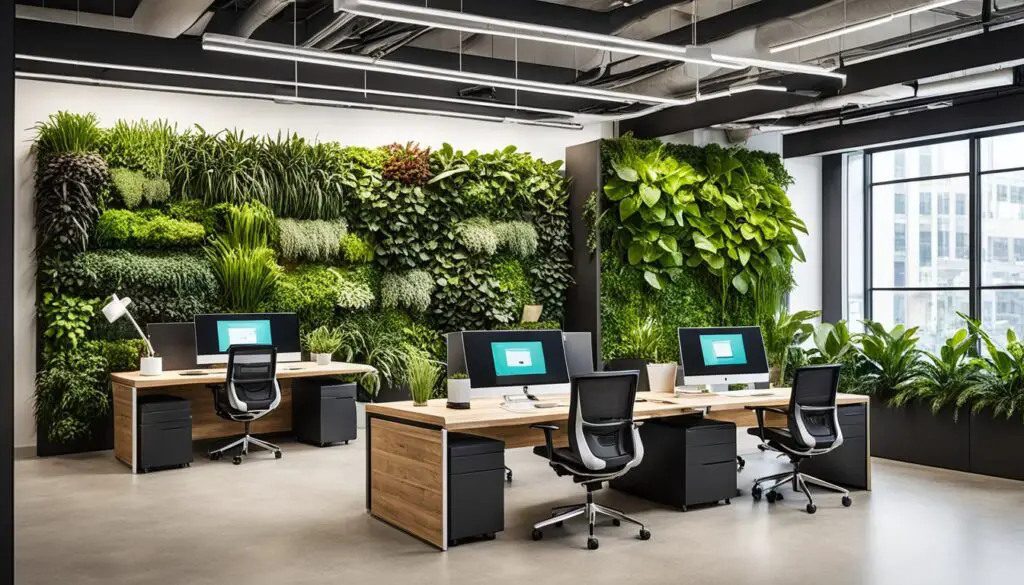
| Biophilic Design Elements | Benefits |
|---|---|
| Outdoor materials | Integration with nature, enhanced visual appeal |
| Commissioned artwork | Depicting local landmarks, connection with the surrounding environment |
| Workspace variety | Supporting diverse work styles and collaboration |
These case studies demonstrate how biophilic design principles can be successfully implemented to create office spaces that prioritize employee well-being and engagement. By incorporating natural elements and sustainable strategies, companies can transform their offices into green workspaces that promote productivity, creativity, and overall satisfaction.
The Role of Technology in Enhancing Biophilic Design in Office Spaces
Technology plays a crucial role in enhancing biophilic design in office spaces, offering new possibilities for creating dynamic and engaging work environments. By leveraging various technological innovations, organizations can further integrate elements of nature into their office designs, promoting employee well-being and productivity.
One key area where technology makes a significant impact is in lighting systems. Smart lighting systems can mimic natural lighting patterns, adjusting throughout the day to replicate the softer hues of dawn and dusk. This dynamic lighting not only contributes to a more visually appealing workspace but also aligns with the body’s natural circadian rhythm, promoting better sleep patterns and overall well-being.
“Smart lighting systems can mimic natural lighting patterns, creating a more dynamic and engaging workspace.”
Additionally, the integration of green building technologies and sustainable materials can enhance the environmental benefits of biophilic design. By incorporating energy-efficient systems and sustainable materials into the office infrastructure, organizations can reduce their ecological footprint while cultivating a more eco-friendly work environment. This not only aligns with sustainable practices but also showcases a commitment to environmental stewardship.
Virtual reality (VR) and augmented reality (AR) technologies offer exciting opportunities to create immersive natural environments within office spaces. Using VR or AR, employees can experience virtual nature, complete with lush landscapes and soothing sounds, promoting relaxation and reducing stress levels. These technologies can be particularly beneficial in urban environments where access to actual natural environments may be limited.
Examples of Technologies that Enhance Biophilic Design in Office Spaces
| Technology | Description |
|---|---|
| Smart Lighting Systems | Intelligent lighting systems that mimic natural lighting patterns to enhance the workspace ambiance and support circadian rhythm. |
| Green Building Technologies | Incorporation of energy-efficient systems and sustainable materials to create eco-friendly office environments. |
| Virtual Reality and Augmented Reality | Technologies that create immersive natural environments within the office space, promoting relaxation and reducing stress levels. |
By harnessing the power of technology, organizations can take biophilic design to new heights, creating innovative office spaces that blend the benefits of nature with the convenience and functionality of modern technology. The integration of smart lighting systems, sustainable materials, and virtual reality technologies paves the way for more visually appealing, environmentally conscious, and employee-centric workspaces.
Implementing Biophilic Design: Considerations and Challenges
Implementing biophilic design in office spaces offers numerous benefits, but it also requires careful consideration and planning. There are several key considerations and challenges to address when incorporating biophilic design strategies.
1. Budget Constraints
One of the primary challenges of implementing biophilic design is budget constraints. Integrating natural elements into office spaces, such as plants, green walls, and natural materials, can be costly. It is essential to allocate sufficient funds to ensure the successful implementation of biophilic design strategies.
2. Space Limitations
Another consideration is space limitations. Some office spaces may have limited area available for the inclusion of natural elements. It is crucial to assess the available space and determine how biophilic design can be integrated effectively within these constraints. Creative solutions, such as vertical gardens or smaller potted plants, can be utilized in compact work environments.
3. Ongoing Maintenance and Care
Creating a biophilic office space involves the use of living elements, such as plants, that require regular maintenance and care. This includes watering, pruning, and ensuring adequate sunlight. Organizations should consider the resources and personnel required to maintain these elements to ensure their continued health and vitality.
“Implementing biophilic design in office spaces requires careful planning and evaluation to address considerations such as budget constraints, space limitations, and ongoing maintenance and care.”
4. Employee Needs and Preferences
Every office has a diverse workforce with varying needs and preferences. It is crucial to consider the specific requirements of employees when implementing biophilic design. This can involve conducting surveys or consultations to understand their preferences for natural elements, lighting, and overall workspace design. Creating a space that aligns with employees’ preferences can enhance their well-being and productivity.
5. Overall Organization Goals and Objectives
When implementing biophilic design, it is essential to align it with the organization’s goals and objectives. The design should reflect the company’s values and contribute to a positive work environment that promotes collaboration, creativity, and employee satisfaction. Biophilic design should not only focus on aesthetics but also support the organization’s overall mission.
To implement biophilic design successfully, it is crucial to address these considerations and challenges. By carefully planning and evaluating each aspect, organizations can create office spaces that not only incorporate natural elements but also cater to employee needs and align with the organization’s goals and objectives.
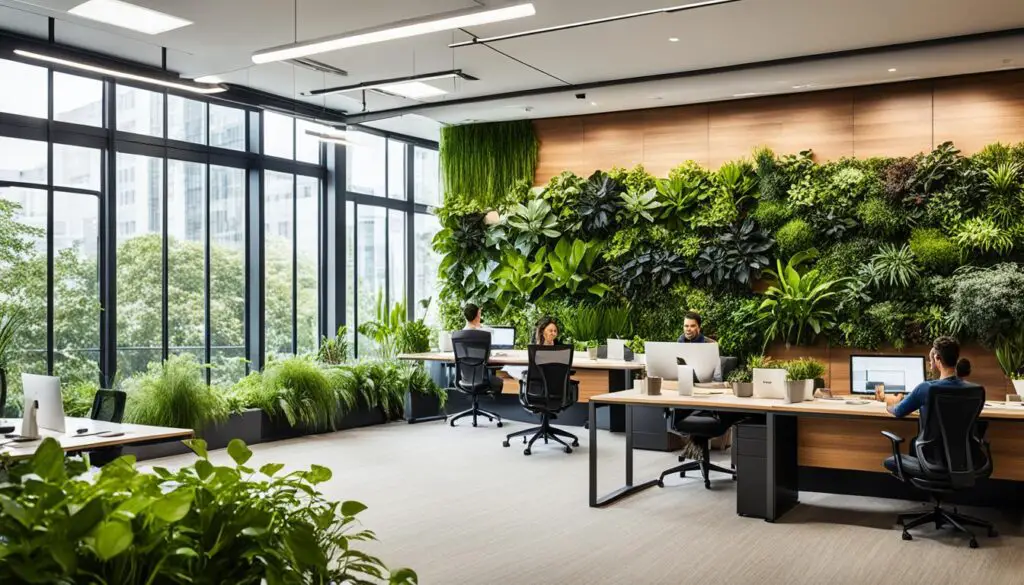
Conclusion
Biophilic design presents a promising solution for cultivating green workspaces within office environments. By seamlessly integrating natural elements such as organic materials, lush vegetation, and ample natural light, these office spaces can significantly enhance employee well-being, productivity, and overall satisfaction. Although the implementation of biophilic design strategies requires careful planning and consideration, the potential benefits make it an endeavor worth pursuing for organizations aiming to foster a healthy and engaging work environment.
Creating a biophilic office space goes beyond mere aesthetics; it is about improving the quality of the work environment and the experiences of the individuals within it. Studies have consistently shown that exposure to nature has a positive impact on employee health, reducing stress levels and enhancing mental clarity. Biophilic design addresses this need by bringing elements of the natural world into the built environment, providing a sense of connection and serenity even in busy office settings.
Implementing biophilic design in office spaces requires careful consideration of the specific needs and preferences of employees, as well as the available resources and constraints. By collaborating with architects, designers, and employee wellness experts, organizations can successfully create green workspaces that promote creativity, collaboration, and a sense of harmony with nature. As the demand for sustainable and employee-centric workplaces continues to grow, incorporating biophilic design principles will become increasingly essential for organizations striving to attract and retain top talent.
FAQ
What is biophilic design?
Biophilic design is a design approach that incorporates elements of nature into the built environment, such as natural materials, vegetation, and natural light.
What are the benefits of biophilic design in office spaces?
Biophilic design has been shown to have a positive impact on employees’ health, happiness, and productivity. It can reduce stress, improve focus, creativity, and overall well-being, and create a more pleasant and inviting atmosphere.
What are some biophilic design strategies that can be implemented in office spaces?
Some biophilic design strategies include the use of natural materials, integration of plants and greenery, maximization of natural light, and incorporation of natural patterns and textures.
Can you provide examples of successful implementations of biophilic design in office spaces?
One example is the LinkedIn office expansion in Singapore, which incorporated outdoor materials, commissioned artwork depicting local landmarks, and a variety of workspace types. Other companies have also embraced biophilic design by incorporating elements such as living walls, natural light, and ergonomic furniture.
How can technology enhance biophilic design in office spaces?
Technology can enhance biophilic design through the use of smart lighting systems that mimic natural lighting patterns, the integration of green building technologies and sustainable materials, and the utilization of virtual reality and augmented reality technologies to create immersive natural environments.
What considerations and challenges should be addressed when implementing biophilic design in office spaces?
Considerations and challenges include budget constraints, space limitations, and the ongoing maintenance and care of natural elements. It is important to carefully plan and evaluate the feasibility of incorporating biophilic design, considering factors such as employee needs and preferences, available resources, and organizational goals.
What are the potential benefits of implementing biophilic design in office spaces?
Implementing biophilic design can create green workspaces that are conducive to employee well-being, productivity, and overall satisfaction. It enhances the aesthetic appeal of the environment and creates a more engaging and healthy work environment.
Source Links
- https://globaldesignnews.com/considering-tomorrows-needs-sca-design-linkedin-office-expansion-focuses-on-bringing-the-outside-in-and-incorporating-local-elements-within-the-office-space/
- https://www.corporatewellnessmagazine.com/article/innovative-approaches-to-employee-health-and-wellness
- https://www.linkedin.com/advice/0/youre-designing-new-workspace-how-can-you-ensure-evewe



